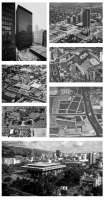Effects, Fictions, and Contradictions of American Government Architecture
Daniel M. Abramson

Clockwise from upper left: Chicago Federal Center; Albany Empire State Plaza; Boston Government Center; New Orleans Civic Center; Honolulu Capitol District and Civic Center; Scottsdale (Arizona) Civic Center; Orange County (California) Civic Center.
MIT Press
Daniel M. Abramson, “Effects, Fictions, and Contradictions of American Government Architecture,” Grey Room, no. 101 (Fall 2025): 82–101.
Filed under architecture, politics

